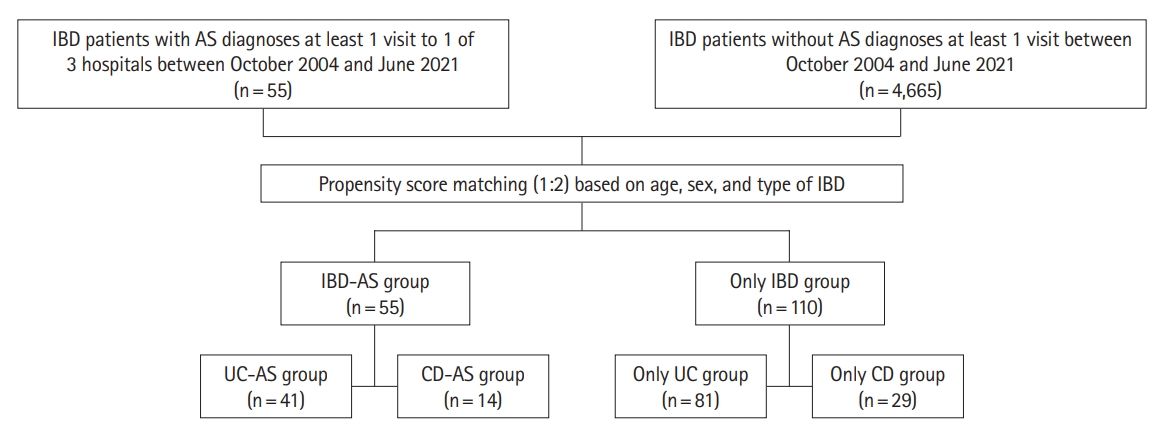 |
 |
- Search
| Intest Res > Volume 21(2); 2023 > Article |
|
Abstract
Background/Aims
Methods
Results
ADDITIONAL INFORMATION
Funding Source
The authors received no financial support for the research, authorship, and/or publication of this article.
Conflict of Interest
Lee HJ and Kang HW are editorial board members of the journal but were not involved in the peer reviewer selection, evaluation, or decision process of this article. No other potential conflicts of interest relevant to this article were reported.
Author Contributions
Conceptualization: Yoon H, Koh SJ, Park JW, Kang HW. Formal analysis: Jun YK, Kim AH, Kim KW. Methodology: Yoon H, Koh SJ, Park JW, Kang HW. Project administration: Lee HJ, Im JP, Park YS, Kim JS. Writing - original draft: Jun YK. Writing - review & editing: Jun YK, Yoon H, Koh SJ. Approval of final manuscript: all authors.
Supplementary Material
Fig.┬Ā1.

Table┬Ā1.
Table┬Ā2.
| Characteristics | IBD-only group (n = 110) | IBD-AS group (n = 55) | P-value | |
|---|---|---|---|---|
| Age (yr) | 44.0 ┬▒ 12.8 | 42.7 ┬▒ 14.3 | 0.544 | |
| Age at IBD diagnosis (yr) | 31.3 ┬▒ 11.7 | 31.7 ┬▒ 14.2 | 0.858 | |
| Sex | Male | 78 (70.9) | 36 (65.5) | 0.592 |
| Female | 32 (29.1) | 19 (34.5) | ||
| IBD | CD | 27 (24.5) | 14 (25.5) | 1.000 |
| UC | 83 (75.5) | 41 (74.5) | ||
| Surgery | No | 91 (82.7) | 49 (89.1) | 0.398 |
| Yes | 19 (17.3) | 6 (10.9) | ||
| 1 | 8 (42.1) | 2 (33.3) | 0.535 | |
| 2 | 2 (10.5) | 2 (33.3) | ||
| 3 | 3 (15.8) | 1 (16.7) | ||
| 4 | 2 (10.5) | 1 (16.7) | ||
| 5 | 1 (5.3) | 0 | ||
| Bowel resection | No | 98 (89.1) | 49 (89.1) | 1.000 |
| Yes | 12 (10.9) | 6 (10.9) | ||
| 1 | 10 (83.3) | 4 (66.7) | 0.688 | |
| 2 | 1 (8.3) | 2 (33.3) | ||
| 3 | 1 (8.3) | 0 | ||
| Emergency room | No | 75 (68.2) | 42 (76.4) | 0.363 |
| Yes | 35 (31.8) | 13 (23.6) | ||
| 1 | 14 (40.0) | 5 (38.5) | 0.342 | |
| 2 | 9 (25.7) | 2 (15.4) | ||
| 3 | 5 (14.3) | 0 | ||
| 4 | 0 | 3 (23.1) | ||
| 5 | 2 (5.7) | 0 | ||
| Ōēź6 | 5 (14.3) | 3 (23.1) | ||
| Biologics or small molecules | No | 96 (87.3) | 40 (72.7) | 0.036 |
| Yes | 14 (12.7) | 15 (27.3) | ||
| 1 | 8 (57.1) | 10 (66.7) | 0.024 | |
| 2 | 4 (28.6) | 3 (20.0) | ||
| 3 | 1 (7.1) | 1 (6.7) | ||
| 4 | 1 (7.1) | 0 | ||
| 5 | 0 | 1 (6.7) | ||
| Immunomodulators | No | 74 (67.3) | 38 (69.1) | 0.953 |
| Yes | 36 (32.7) | 17 (30.9) | ||
| 1 | 21 (58.3) | 1 (5.9) | 0.002 | |
| 2 | 15 (41.7) | 16 (94.1) | ||
| Hypertension | No | 106 (96.4) | 52 (94.5) | 0.687 |
| Yes | 4 (3.6) | 3 (5.5) | ||
| Type 2 DM | No | 100 (90.9) | 53 (96.4) | 0.203 |
| Yes | 10 (9.1) | 2 (3.6) | ||
| Dyslipidemia | No | 109 (99.1) | 54 (98.2) | 0.615 |
| Yes | 1 (0.9) | 1 (1.8) | ||
| Immune-mediated diseasea | No | 102 (92.7) | 50 (90.9) | 0.683 |
| Yes | 8 (7.3) | 5 (9.1) | ||
| Gastrointestinal cancer | No | 108 (98.2) | 55 (100.0) | 0.314 |
| Yes | 2 (1.8) | 0 |
a Immune-mediated disease included Beh├¦etŌĆÖs disease, WegenerŌĆÖs disease, systemic lupus, multiple sclerosis, polymyositis, autoimmune hemolytic anemia, thrombocytopenic purpura, Henoch-Schonlein purpura, vitiligo, GravesŌĆÖ disease, type 1 DM, psoriasis, erythema nodosum, pyoderma gangrenosum, celiac disease, autoimmune hepatitis, primary biliary cirrhosis, primary sclerosing cholangitis, polymyalgia rheumatica, rheumatoid arthritis, and hidradenitis.
Table┬Ā3.
| Biologics or small molecules | OR (95% CI) | P-value |
|---|---|---|
| Only IBD group | Reference | < 0.001 |
| IBD-AS group | 4.099 (1.863-9.021) | |
| Ulcerative colitis | Reference | 0.002 |
| CrohnŌĆÖs disease | 3.552 (1.590-7.934) |









